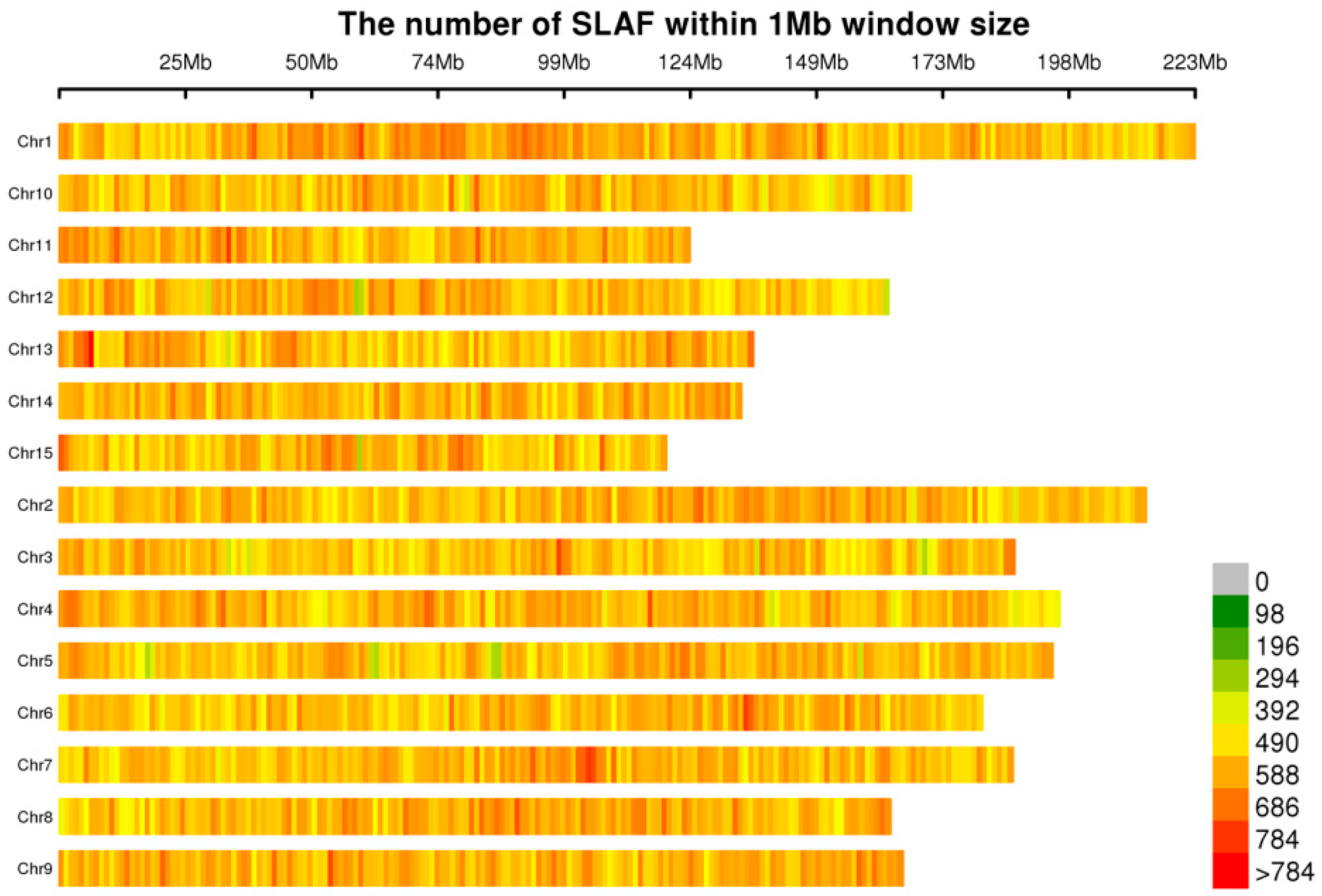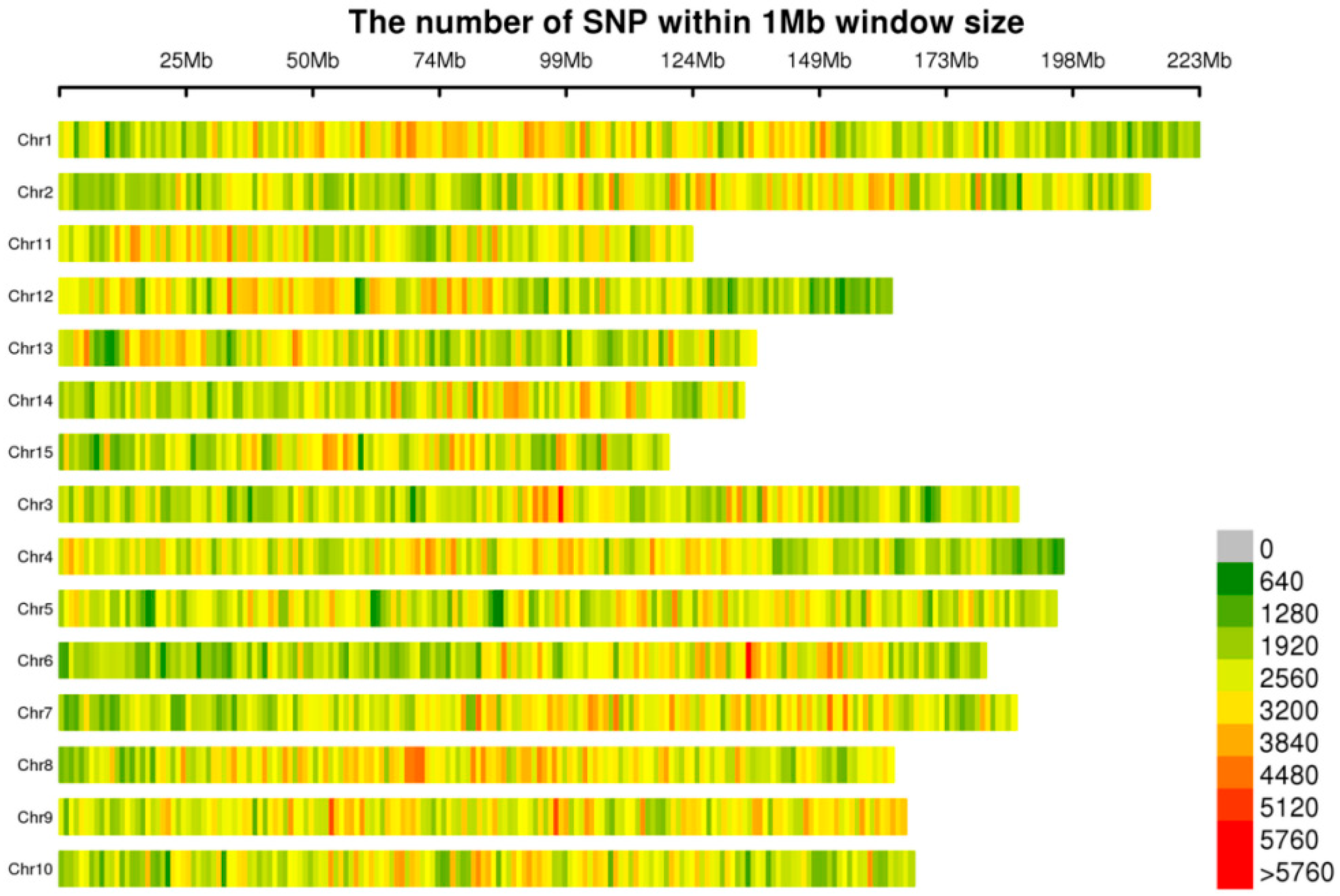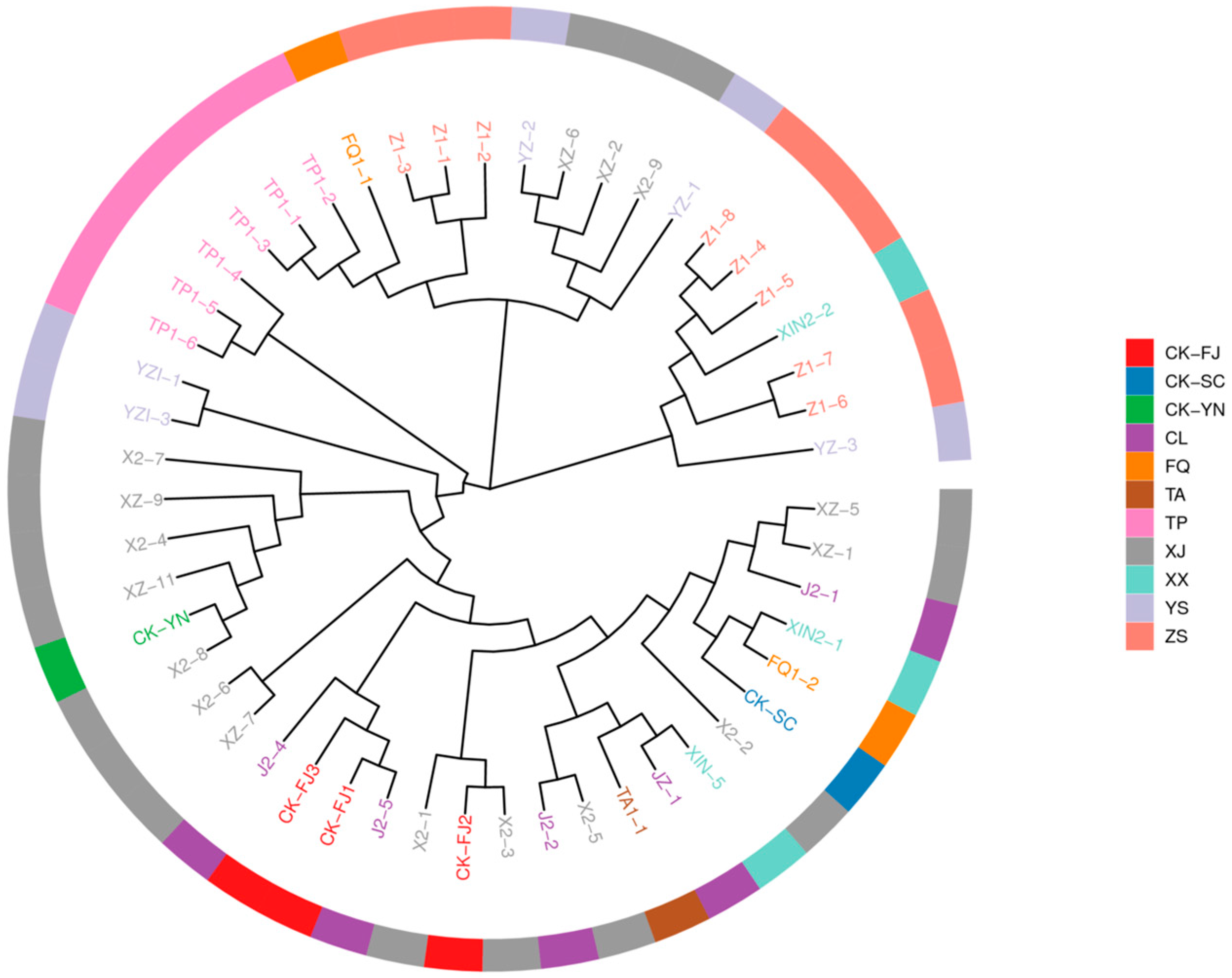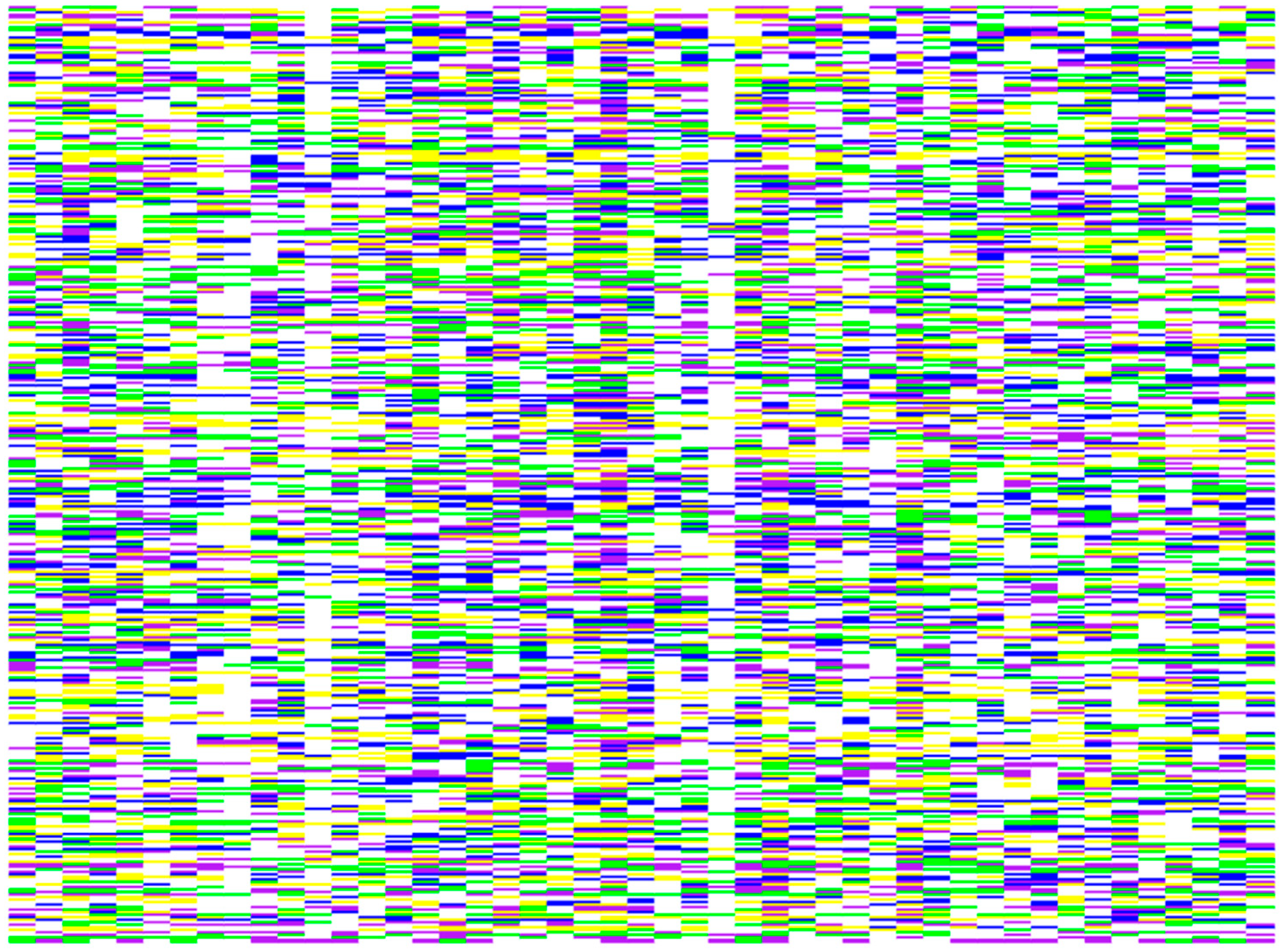Analysis of Genetic Diversity in Tea Plant Population and Construction of DNA Fingerprint Profile Using SNP Markers Identified by SLAF-Seq
Abstract
1. Introduction
2. Materials and Methods
2.1. Plant Materials
2.2. SLAF Library Construction and Sequencing
2.3. Data Analysis Procedure
2.4. The Analysis of the Population Structure of Tea Plants
3. Results
3.1. SLAF-Seq Analysis and SNP Data Identification
3.2. Genetic Diversity and Population Structure of Tea Plant
3.3. Development of DNA Fingerprinting Markers
4. Discussion
5. Conclusions
Supplementary Materials
Author Contributions
Funding
Data Availability Statement
Acknowledgments
Conflicts of Interest
References
- Xia, E.; Li, F.; Tong, W.; Li, P.; Wu, Q.; Zhao, H.; Ge, R.; Li, R.; Li, Y.; Zhang, Z.; et al. Tea Plant Information Archive: A comprehensive genomics and bioinformatics platform for tea plant. Plant Biotechnol. J. 2019, 17, 1938–1953. [Google Scholar] [CrossRef]
- Xie, H.; Zhu, J.; Wang, H.; Zhang, L.; Tong, X.; Huang, F.; Zhang, C.; Mi, X.; Qiao, D.; Li, F.; et al. An Enhancer Transposable Element from the Genome of Purple Leaf Tea Variety Reveals a Genetic Mechanism Turning Leaves from Evergreen to Purple Color. Plant Commun. 2024, 6, 101176. [Google Scholar]
- Li, X.; Lei, W.; You, X.; Kong, X.; Chen, Z.; Shan, R.; Zhang, Y.; Yu, Y.; Wang, P.; Chen, C. The tea cultivar ‘Chungui’ with jasmine-like aroma: From genome and epigenome to quality. Int. J. Biol. Macromol. 2024, 281, 136352. [Google Scholar] [CrossRef] [PubMed]
- Pan, S.Y.; Nie, Q.; Tai, H.C.; Song, X.L.; Tong, Y.F.; Zhang, L.J.F.; Wu, X.W.; Lin, Z.H.; Zhang, Y.Y.; Ye, D.Y.; et al. Tea and tea drinking: China’s outstanding contributions to the mankind. Chin. Med. 2022, 17, 27. [Google Scholar] [CrossRef]
- Zhang, W.H.; Yan, Y.; Yu, R.L.; Hu, G.R. The sources-specific health risk assessment combined with APCS/MLR model for heavy metals in tea garden soils from south Fujian Province, China. Catena 2021, 203, 105306. [Google Scholar] [CrossRef]
- Long, P.; Su, S.; Han, Z.; Granato, D.; Hu, W.; Ke, J.; Zhang, L. The effects of tea plant age on the color, taste, and chemical characteristics of Yunnan Congou black tea by multi-spectral omics insight. Food Chem. X 2024, 21, 101190. [Google Scholar] [CrossRef]
- Ge, Y.; Wang, L.; Huang, Y.; Jia, L.; Wang, J. Characteristic flavor compounds in Guizhou green tea and the environmental factors influencing their formation: Investigation using stable isotopes, electronic nose, and headspace-gas chromatography ion migration spectrometry. LWT 2024, 196, 115887. [Google Scholar] [CrossRef]
- Zou, Y.; Li, X.; Han, D. Multidimensional Quality Characteristics of Sichuan South-Road Dark Tea and Its Chemical Prediction. Agronomy 2024, 14, 1582. [Google Scholar] [CrossRef]
- Li, X. A Preliminary Study on Morphological and Genetic Diversity of Small-Leaf Tea Populations in Sichuan. Master’s thesis, Sichuan Agricultural University, Ya’an, China, 2018. [Google Scholar]
- Milee, A.; Neeta, S.; Harish, P. Advances in molecular marker techniques and their applications in plant sciences. Plant Cell Rep. 2008, 27, 617–631. [Google Scholar]
- Chen, S.; Qi, G.; Li, H.; Zou, Y.; Shan, H. PCR-RFLP Analysis of cpDNA in Tea Cultivars (Camellia sinensis L.) in Sichuan of China. J. Agric. Sci. 2012, 4, 25. [Google Scholar] [CrossRef]
- Devi, A.M.; Goel, S.; Misra, A.K. Generation of silver stained TE-AFLP markers in tea (Camellia sinensis) and their assessment in filling gaps with construction of a genetic linkage map. Sci. Hortic. 2015, 192, 293–301. [Google Scholar] [CrossRef]
- Yao, Y.X.; Zhang, M.Z.; Liu, L.P.; Chen, S.J.; Li, J. SSR Analysis of Genetic Diversity and Construction of Fingerprint Profiles of Tea Germplasm Resources in Duyun. Mol. Plant Breed. 2021, 19, 3653–3660. [Google Scholar]
- Cai, Y.; Wang, D.; Che, Y.; Wang, L.; Zhang, F.; Liu, T.; Sheng, Y. Multiple Localization Analysis of the Major QTL-sfw 2.2 for Controlling Single Fruit Weight Traits in Melon Based on SLAF Sequencing. Genes 2024, 15, 1138. [Google Scholar] [CrossRef]
- Deng, W.; Li, Y.; Chen, X.; Luo, Y.; Pan, Y.; Li, X.; Zhu, Z.; Li, F.; Liu, X.; Jia, Y. Development of single nucleotide polymorphism(SNP) markers and construction of DNA fingerprinting of Alcea rosea L. based on specific-locus amplified fragment sequencing (SLAF-seq) technology. Genet. Resour. Crop Evol. 2025, 72, 2307–2321. [Google Scholar] [CrossRef]
- Yang, Q.; Guo, Z.; Xu, Y.; Wang, Y. Genetic diversity and population structure of sweet corn in China as revealed by mSNP. Mol. Breed. 2024, 45, 1–7. [Google Scholar] [CrossRef] [PubMed]
- Mazumder, A.K.; Budhlakoti, N.; Kumar, M.; Pradhan, A.K.; Kumar, S.; Babu, P.; Yadav, R.; Gaikwad, K.B. Exploring the genetic diversity and population structure of an ancient hexaploid wheat species Triticum sphaerococcum using SNP markers. BMC Plant Biol. 2024, 24, 1188. [Google Scholar] [CrossRef]
- Cheng, L.; Dong, X.; Liu, Q.; Wang, R.; Li, Y.; Huang, X.; Zhao, Y. SLAF-Seq Technology-Based Genome-Wide Association and Population Structure Analyses of Ancient Camellia sinensis (L.) Kuntze in Sandu County, China. Forests 2022, 13, 1885. [Google Scholar] [CrossRef]
- Guangdong, G.; Lijie, C.; Suqin, Z. Development of SNP loci in ancient tea plants based on SLAF-seq technology. J. Econ. For. Res. 2019, 37, 7–12. [Google Scholar]
- Li, T.H.; Ge, W.F.; Ran, Z.J.; Mei, Y.H.; Lu, W.L.; Rui, W.; Yang, Y.; Wei, S. Development of maizeSNP3072, a high-throughput compatible SNP array, for DNA fingerprinting identification of Chinese maize varieties. Mol. Breed. 2015, 2015, 35. [Google Scholar]
- Wang, Y.; Lv, H.; Xiang, X.; Yang, A.; Feng, Q.; Dai, P.; Li, Y.; Jiang, X.; Liu, G.; Zhang, X. Construction of a SNP Fingerprinting Database and Population Genetic Analysis of Cigar Tobacco Germplasm Resources in China. Front. Plant Sci. 2021, 12, 166. [Google Scholar] [CrossRef]
- Ma, K.; Li, D.; Qi, X.; Li, Q.; Wu, Y.; Song, J.; Zhang, Y.; Yang, H.; Li, T.; Ma, Y. Population structure, runs of homozygosity analysis and construction of single nucleotide polymorphism fingerprinting database of Longnan goat population. Food Energy Secur. 2023, 13, e517. [Google Scholar] [CrossRef]
- Button, P. The International Union for the Protection of New Varieties of Plants (UPOV) Recommendations on Variety Denominations. Acta Hortic. 2008, 799, 191–200. [Google Scholar] [CrossRef]
- Liu, C.; Yu, W.; Cai, C.; Huang, S.; Wu, H.; Wang, Z.; Wang, P.; Zheng, Y.; Wang, P.; Ye, N. Genetic diversity of tea plant (Camellia sinensis (L.) Kuntze) germplasm resources in Wuyi Mountain of China based on Single Nucleotide Polymorphism (SNP) markers. Horticulturae 2022, 8, 932. [Google Scholar] [CrossRef]
- Fang, W.P.; Meinhardt, L.W.; Tan, H.W.; Zhou, L.; Mischke, S.; Zhang, D. Varietal identification of tea (Camellia sinensis) using nanofluidic array of single nucleotide polymorphism (SNP) markers. Hortic. Res. 2014, 1, 14035. [Google Scholar] [CrossRef]
- Tadeo, K.; Ronald, K.; Vereriano, T.; Robooni, T. Genetic diversity and structure of Ugandan tea (Camellia sinensis (L.) O. Kuntze) germplasm and its implication in breeding. Genet. Resour. Crop. Evol. 2024, 71, 481–496. [Google Scholar] [CrossRef]
- Sun, X.; Liu, D.; Zhang, X.; Li, W.; Liu, H.; Hong, W.; Jiang, C.; Guan, N.; Ma, C.; Zeng, H.; et al. SLAF-seq: An Efficient Method of Large-Scale De Novo SNP Discovery and Genotyping Using High-Throughput Sequencing. PLoS ONE 2013, 8, e58700. [Google Scholar] [CrossRef]
- Li, H.; Durbin, R. Fast and accurate short read alignment with Burrows—Wheeler transform. Bioinformatics 2009, 25, 1754–1760. [Google Scholar] [CrossRef]
- McKenna, A.; Hanna, M.; Banks, E.; Sivachenko, A.; Cibulskis, K.; Kernytsky, A.; Garimella, K.; Altshuler, D.; Gabriel, S.; Daly, M.; et al. The Genome Analysis Toolkit: A MapReduce framework for analyzing next-generation DNA sequencing data. Genome Res. 2010, 20, 1297–1303. [Google Scholar] [CrossRef]
- Li, H.; Handsaker, B.; Wysoker, A.; Fennell, T.; Ruan, J.; Homer, N. The Sequence Alignment/Map format and SAMtools. Bioinformatics 2009, 25, 2078–2079. [Google Scholar] [CrossRef]
- Kumar, S.; Stecher, G.; Li, M.; Knyaz, C.; Tamura, K. MEGA X: Molecular Evolutionary Genetics Analysis Across Computing Platforms. Mol. Biol. Evol. 2018, 35, 1547–1549. [Google Scholar] [CrossRef]
- Dolferus, R.; Onyemaobi, O. Editorial on Genetic Diversity of Plant Tolerance to Environmental Restraints. Genes 2023, 14, 1992. [Google Scholar] [CrossRef] [PubMed]
- Wang, Z.; Sun, Y.; Huang, X.; Li, F.; Liu, Y.; Zhu, H.; Liu, Z.; Ke, W. Genetic diversity and population structure of eddoe taro in China using genome-wide SNP markers. PeerJ 2020, 8, e10485. [Google Scholar] [CrossRef] [PubMed]
- Fang, H.; Liu, H.; Ma, R.; Liu, Y.; Li, J.; Yu, X.; Zhang, H.; Yang, Y.; Zhang, G. Genome-wide assessment of population structure and genetic diversity of Chinese Lou onion using specific length amplified fragment (SLAF) sequencing. PLoS ONE 2020, 15, e231753. [Google Scholar] [CrossRef]
- Li, Y.; Zeng, X.-F.; Zhao, Y.-C.; Li, J.-R.; Zhao, D.-G. Identification of a New Rice Low-Tiller Mutant and Association Analyses Based on the SLAF-seq Method. Plant Mol. Biol. Rep. 2017, 35, 72–82. [Google Scholar] [CrossRef]
- Luo, C.; Shu, B.; Yao, Q.; Wu, H.; Xu, W.; Wang, S. Construction of a High-Density Genetic Map Based on Large-Scale Marker Development in Mango Using Specific-Locus Amplified Fragment Sequencing (SLAF-seq). Front. Plant Sci. 2016, 7, 1310. [Google Scholar] [CrossRef] [PubMed]
- Chen, Z.; He, Y.; Iqbal, Y.; Shi, Y.; Huang, H.; Yi, Z. Investigation of genetic relationships within three Miscanthus species using SNP markers identified with SLAF-seq. BMC Genom. 2022, 23, 43. [Google Scholar] [CrossRef]
- Zhang, H.; Lin, P.; Liu, Y.; Huang, C.; Huang, G.; Jiang, H.; Xu, L.; Zhang, M.; Deng, Z.; Zhao, X. Development of SLAF-Sequence and Multiplex SNaPshot Panels for Population Genetic Diversity Analysis and Construction of DNA Fingerprints for Sugarcane. Genes 2022, 13, 1477. [Google Scholar] [CrossRef]
- Yao, M.Z.; Chen, L.; Liang, Y.R. Genetic diversity among tea cultivars from China, Japan and Kenya revealed by ISSR markers and its implication for parental selection in tea breeding programmes. Plant Breed. 2008, 127, 166–172. [Google Scholar] [CrossRef]
- Tan, L.-Q.; Liu, Q.-L.; Zhou, B.; Yang, C.-J.; Zou, X.; Yu, Y.-Y.; Wang, Y.; Hu, J.-H.; Zou, Y.; Chen, S.-X.; et al. Paternity analysis using SSR markers reveals that the anthocyanin-rich tea cultivar ‘Ziyan’ is self-compatible. Sci. Hortic. 2019, 245, 258–262. [Google Scholar] [CrossRef]
- Sharma, S.; Kumar, A.; Rajpal, V.R.; Singh, A.; Babbar, S.; Raina, S.N. Evaluation of genetic diversity and population structure in elite south Indian tea [Camellia sinensis (L.) Kuntze] using RAPD and ISSR markers. Genet. Resour. Crop Evol. 2022, 70, 381–398. [Google Scholar] [CrossRef]
- Evans, J.C. Tea in China: The History of China’s National Drink; Praeger: Westport, CT, USA, 1992. [Google Scholar]
- Huang, H.; Tong, Y.; Zhang, Q.-J.; Gao, L.-Z. Genome Size Variation among and within Camellia Species by Using Flow Cytometric Analysis. PLoS ONE 2013, 8, e64981. [Google Scholar] [CrossRef] [PubMed]
- Wang, X.; Feng, H.; Chang, Y.; Ma, C.; Wang, L.; Hao, X.; Li, A.; Cheng, H.; Wang, L.; Cui, P.; et al. Population sequencing enhances understanding of tea plant evolution. Nat. Commun. 2020, 11, 4447. [Google Scholar] [CrossRef] [PubMed]
- Lin, Y.; Huang, Y.; Zhou, S.; Li, X.; Tao, Y.; Pan, Y.; Feng, X.; Guo, H.; Chen, P.; Chu, Q. A newly-discovered tea population variety processed Bai Mu Dan white tea: Flavor characteristics and chemical basis. Food Chem. 2024, 446, 138851. [Google Scholar] [CrossRef]
- Luo, F.; Wang, Y.; Liu, D.; Li, C.; Gong, X.; Li, L. Breeding of a New Breakthrough Tea Variety Tianfu No. 1. Agric. Biotechnol. 2018, 7, 150–153. [Google Scholar]
- Niu, S.; Song, Q.; Koiwa, H.; Qiao, D.; Zhao, D.; Chen, Z.; Liu, X.; Wen, X. Genetic diversity, linkage disequilibrium, and population structure analysis of the tea plant (Camellia sinensis) from an origin center, Guizhou plateau, using genome-wide SNPs developed by genotyping-by-sequencing. BMC Plant Biol. 2019, 19, 328. [Google Scholar] [CrossRef]
- Elhaik, E. Empirical Distributions of FST from Large-Scale Human Polymorphism Data. PLoS ONE 2012, 7, e49837. [Google Scholar] [CrossRef] [PubMed]
- Fu, C.; Liu, K.; Zhang, X.; Liang, G.; Jiang, Z.; Wang, L. SNP markers development and genetic structure analysis of Camellia oleifera genetic populations germplasm in Fengshan of Guangxi. Res. Econ. For. 2023, 41, 169–175+186. [Google Scholar]
- Huang, F.; Duan, J.; Lei, Y.; Liu, Z.; Kang, Y.; Luo, Y.; Chen, Y.; Li, Y.; Liu, S.; Li, S.; et al. Genetic diversity, population structure and core collection analysis of Hunan tea plant germplasm through genotyping-by-sequencing. Beverage Plant Res. 2022, 2, 36–42. [Google Scholar] [CrossRef]
- Jiang, L.; Xie, S.; Zhou, C.; Tian, C.; Zhu, C.; You, X.; Chen, C.; Lai, Z.; Guo, Y. Analysis of the Genetic Diversity in Tea Plant Germplasm in Fujian Province Based on Restriction Site-Associated DNA Sequencing. Plants 2023, 13, 100. [Google Scholar] [CrossRef]
- Wang, Y.; Peng, H.; Tong, X.; Ding, X.; Song, C.; Ma, T.; Wang, H.; Wei, W.; Chen, C.; Zhu, J.; et al. Genetic diversity analysis and core germplasm construction of tea plants in Lu’an. BMC Plant Biol. 2025, 25, 253. [Google Scholar] [CrossRef]






| Shannon–Wiener Index | Ave | Min–Max |
|---|---|---|
| Observed allele number | 2.000 | 2.000–2.000 |
| Expected allele number | 1.934 | 1.837–2.000 |
| Observed heterozygous number | 0.469 | 0.298–0.681 |
| Expected heterozygous number | 0.483 | 0.456–0.500 |
| Nei diversity index | 0.488 | 0.461–0.505 |
| Shannon Wiener index | 0.676 | 0.648–0.693 |
| Polymorphism information content | 0.366 | 0.352–0.375 |
| Average MAF | 0.419 | - |
| Number of poly markers | 371.000 | - |
Disclaimer/Publisher’s Note: The statements, opinions and data contained in all publications are solely those of the individual author(s) and contributor(s) and not of MDPI and/or the editor(s). MDPI and/or the editor(s) disclaim responsibility for any injury to people or property resulting from any ideas, methods, instructions or products referred to in the content. |
© 2025 by the authors. Licensee MDPI, Basel, Switzerland. This article is an open access article distributed under the terms and conditions of the Creative Commons Attribution (CC BY) license (https://creativecommons.org/licenses/by/4.0/).
Share and Cite
Liu, Y.; Teng, Y.; Zheng, J.; Khan, A.; Li, X.; Tian, Y.; Cui, J.; Guo, Q. Analysis of Genetic Diversity in Tea Plant Population and Construction of DNA Fingerprint Profile Using SNP Markers Identified by SLAF-Seq. Horticulturae 2025, 11, 529. https://doi.org/10.3390/horticulturae11050529
Liu Y, Teng Y, Zheng J, Khan A, Li X, Tian Y, Cui J, Guo Q. Analysis of Genetic Diversity in Tea Plant Population and Construction of DNA Fingerprint Profile Using SNP Markers Identified by SLAF-Seq. Horticulturae. 2025; 11(5):529. https://doi.org/10.3390/horticulturae11050529
Chicago/Turabian StyleLiu, Yiding, Yanqi Teng, Jie Zheng, Aziz Khan, Xiang Li, Yang Tian, Junlin Cui, and Qigao Guo. 2025. "Analysis of Genetic Diversity in Tea Plant Population and Construction of DNA Fingerprint Profile Using SNP Markers Identified by SLAF-Seq" Horticulturae 11, no. 5: 529. https://doi.org/10.3390/horticulturae11050529
APA StyleLiu, Y., Teng, Y., Zheng, J., Khan, A., Li, X., Tian, Y., Cui, J., & Guo, Q. (2025). Analysis of Genetic Diversity in Tea Plant Population and Construction of DNA Fingerprint Profile Using SNP Markers Identified by SLAF-Seq. Horticulturae, 11(5), 529. https://doi.org/10.3390/horticulturae11050529






